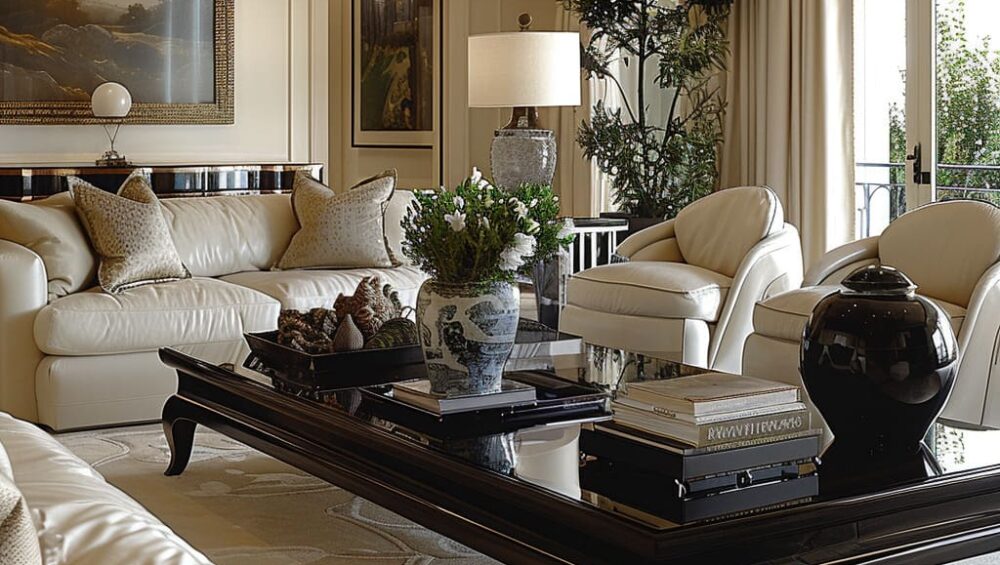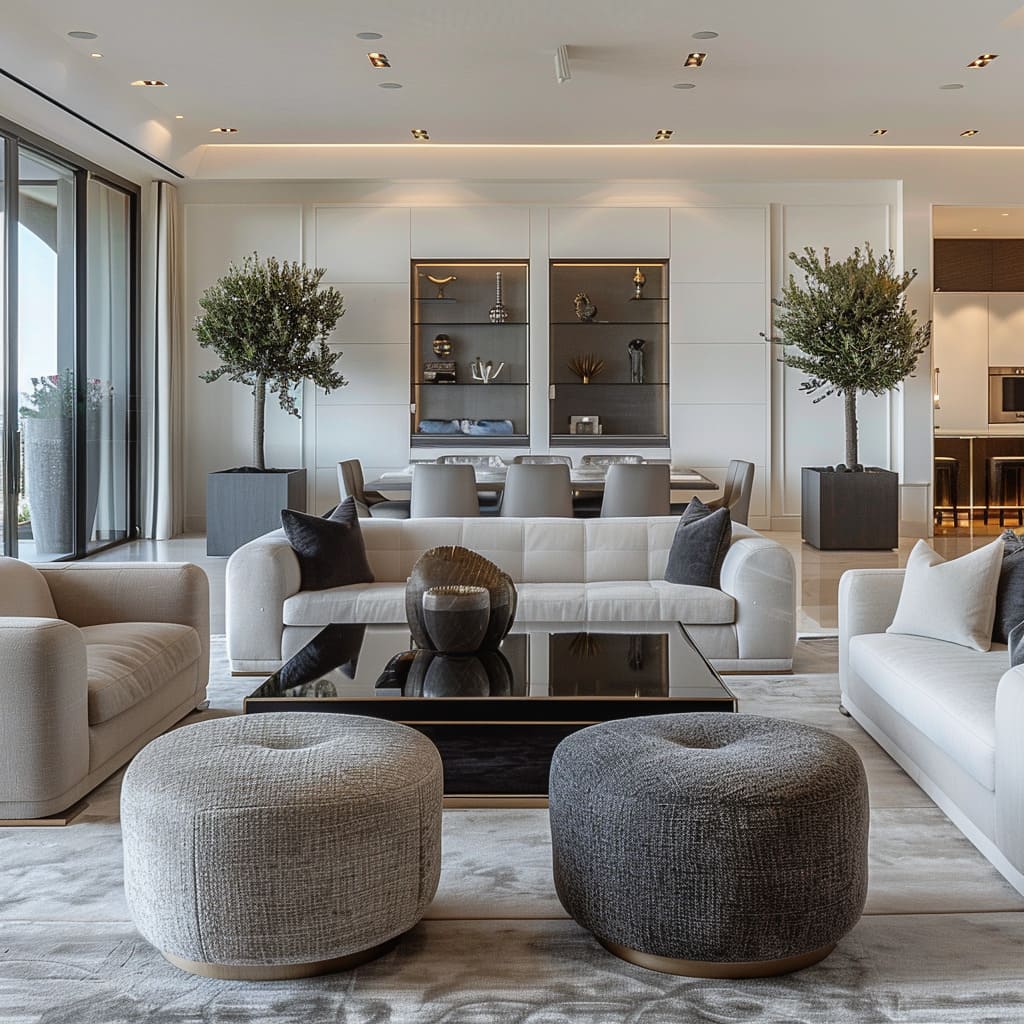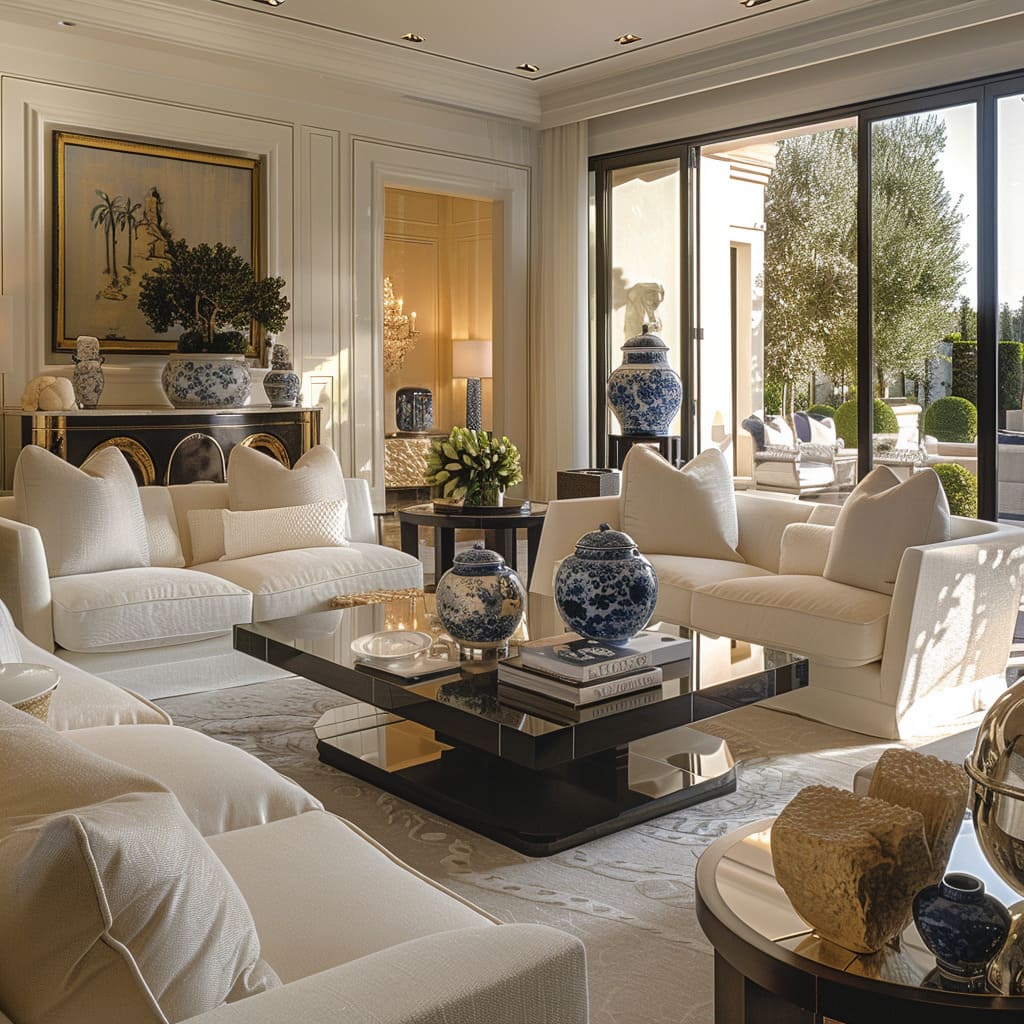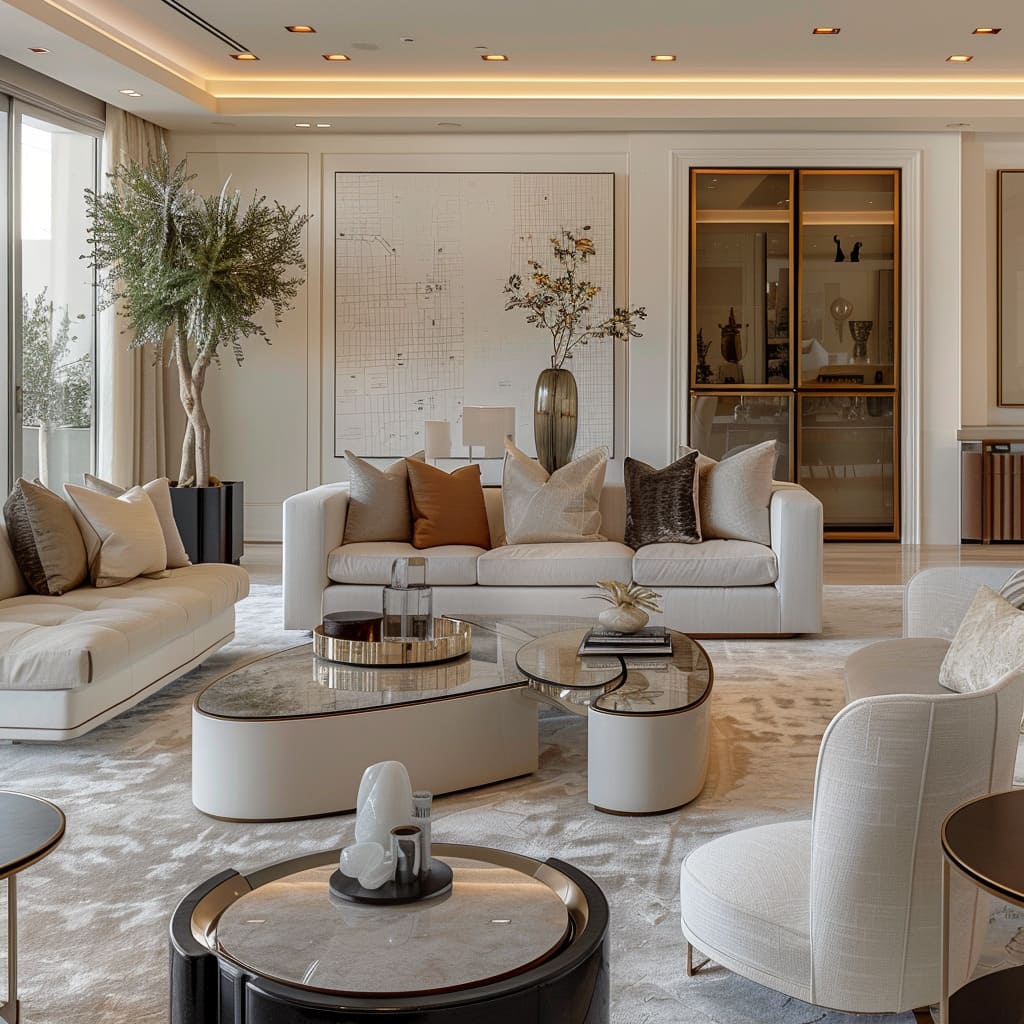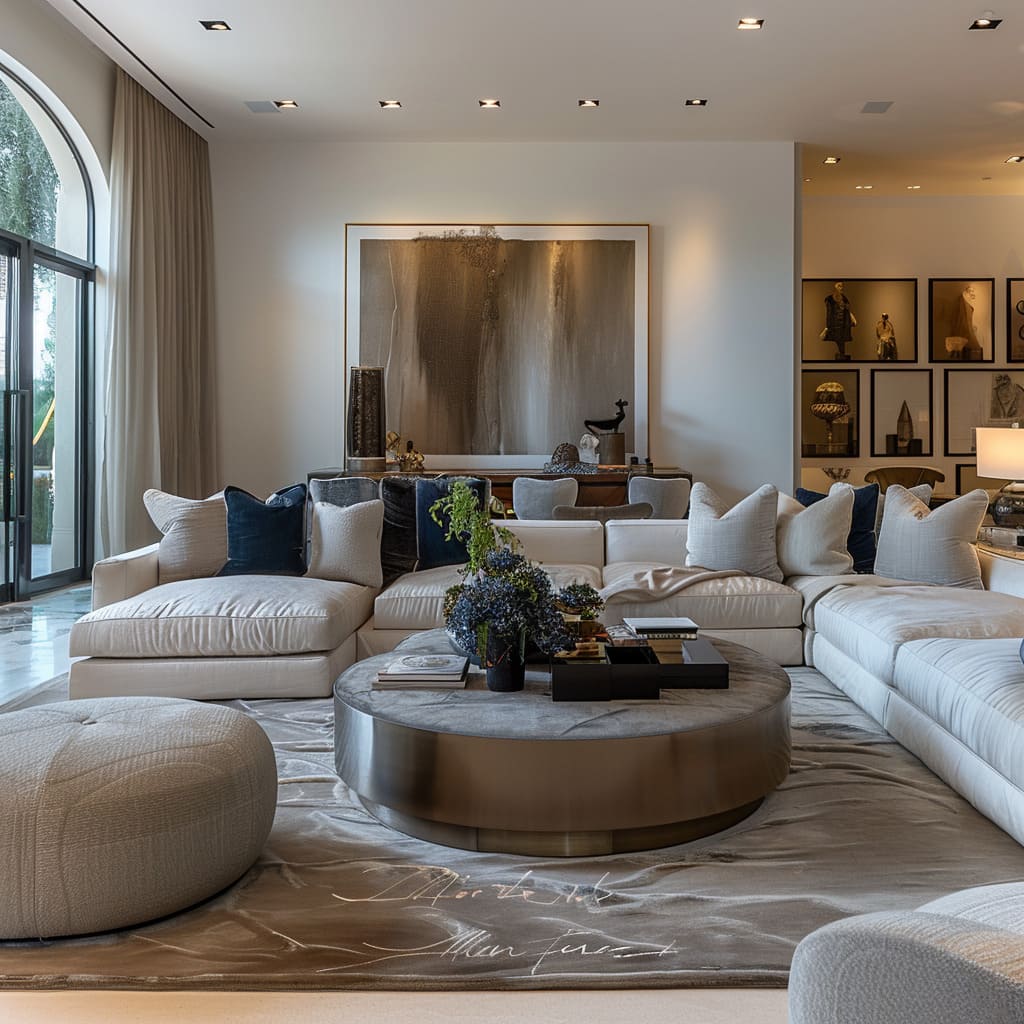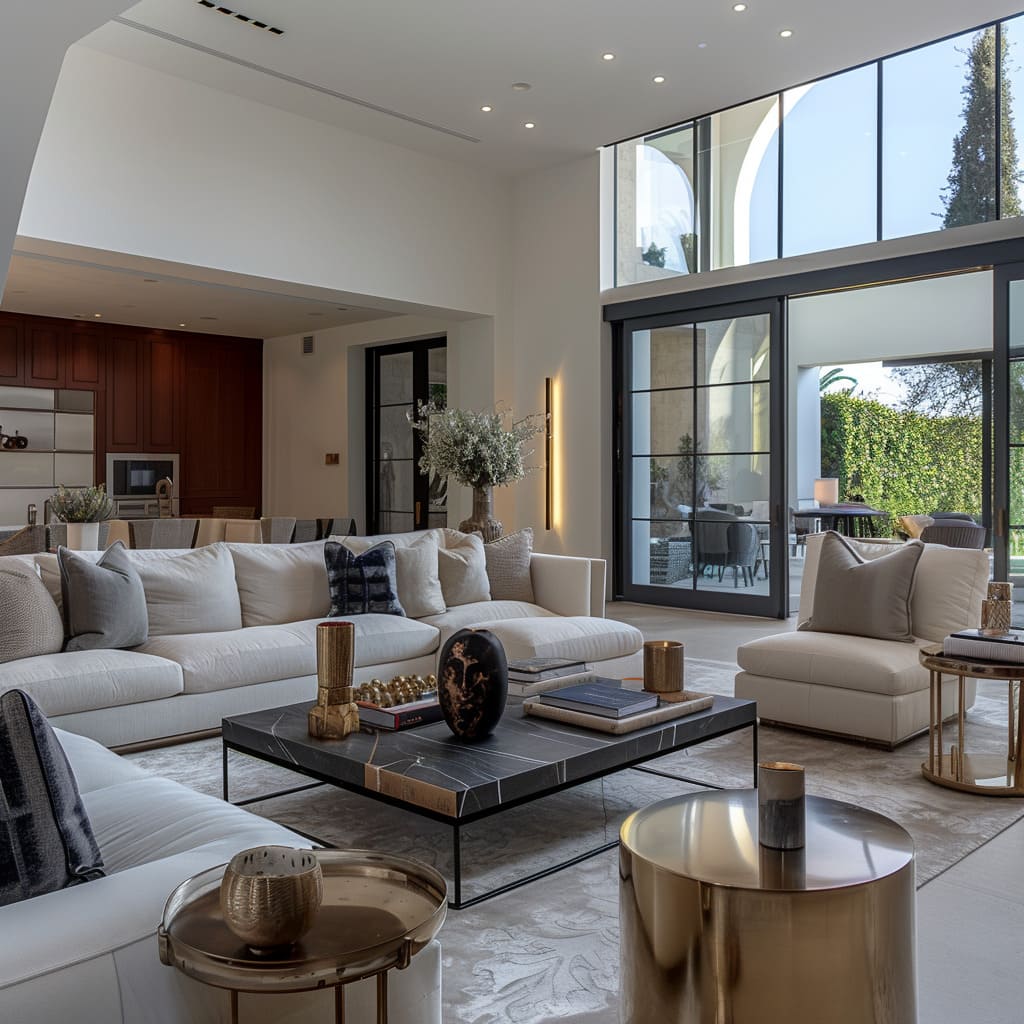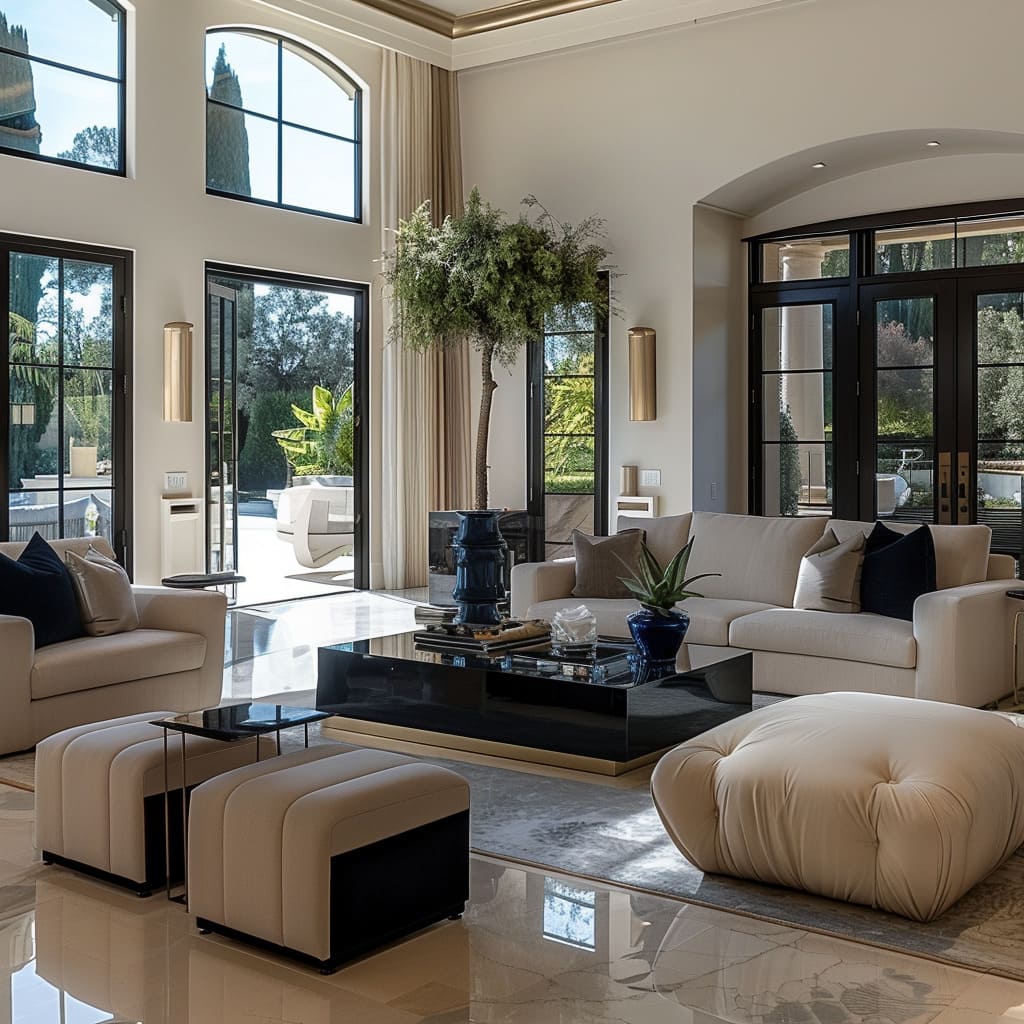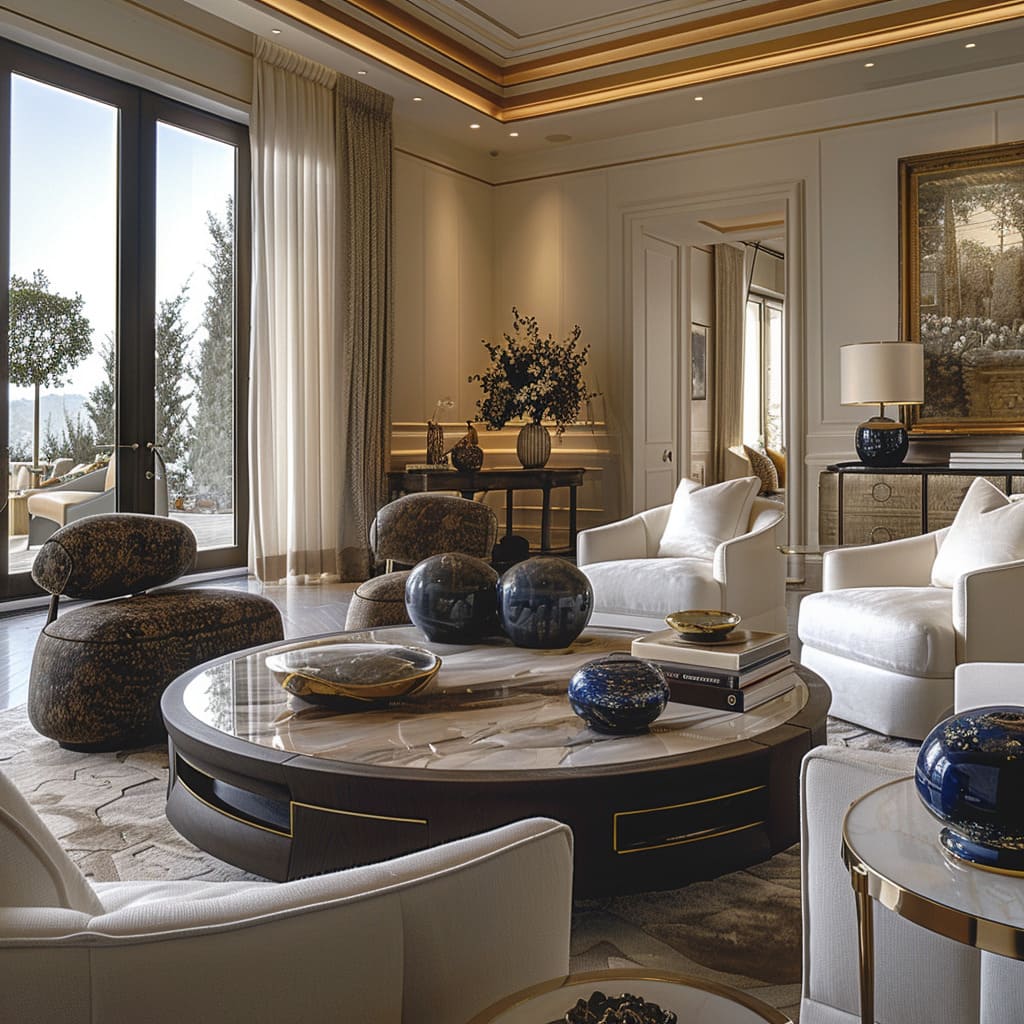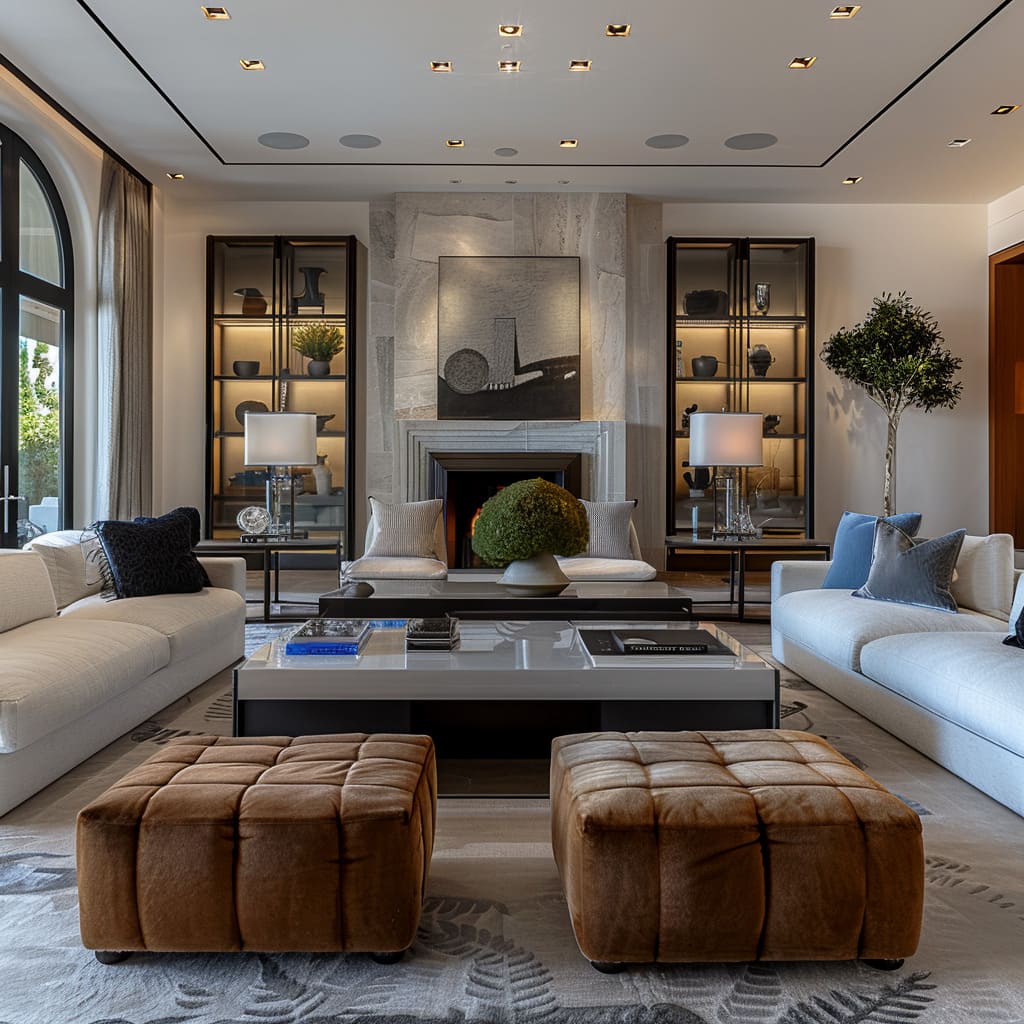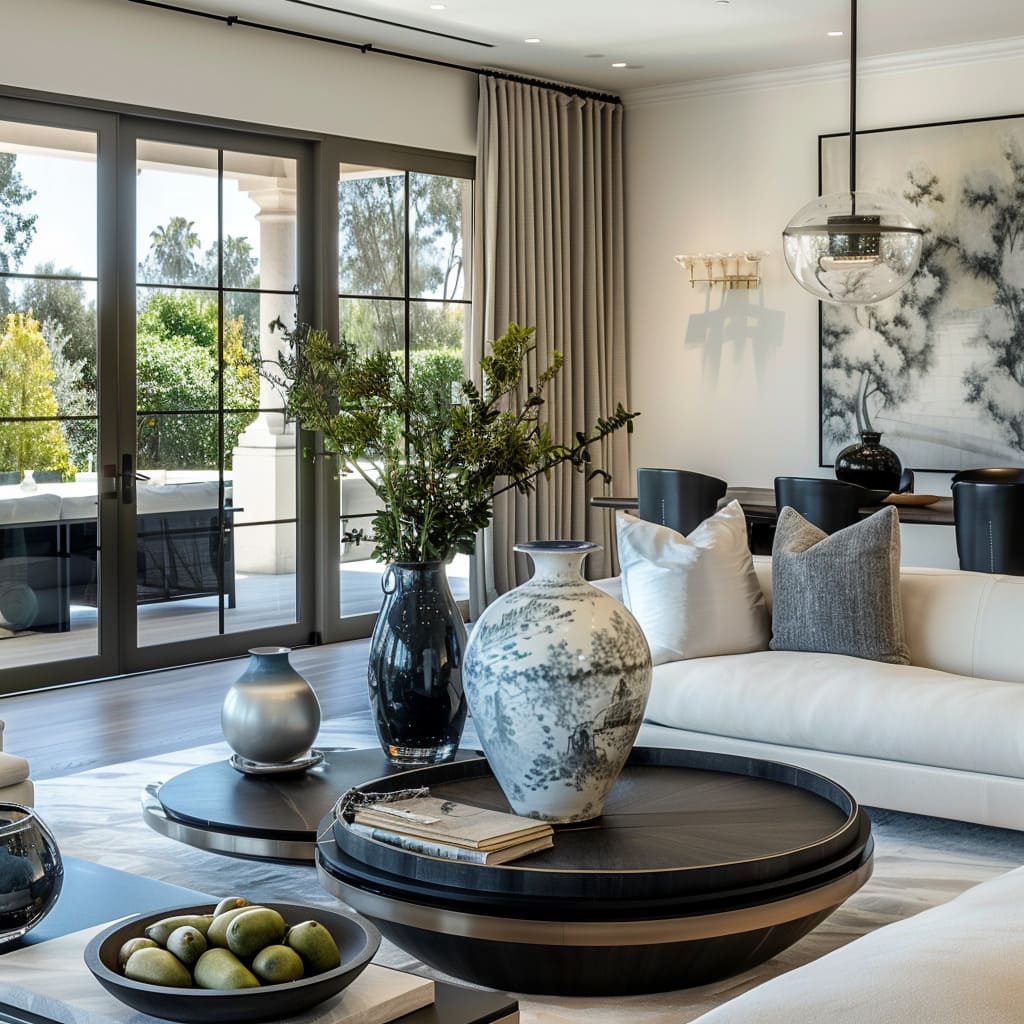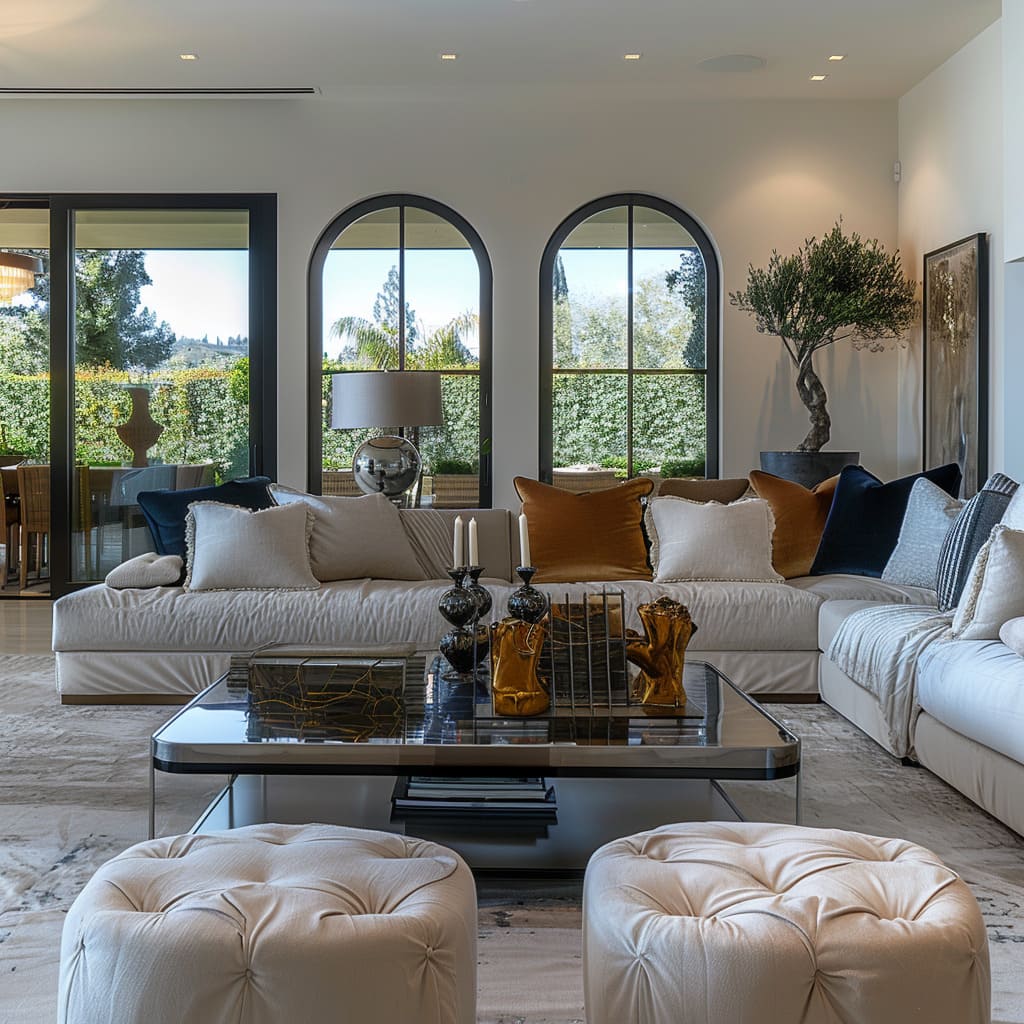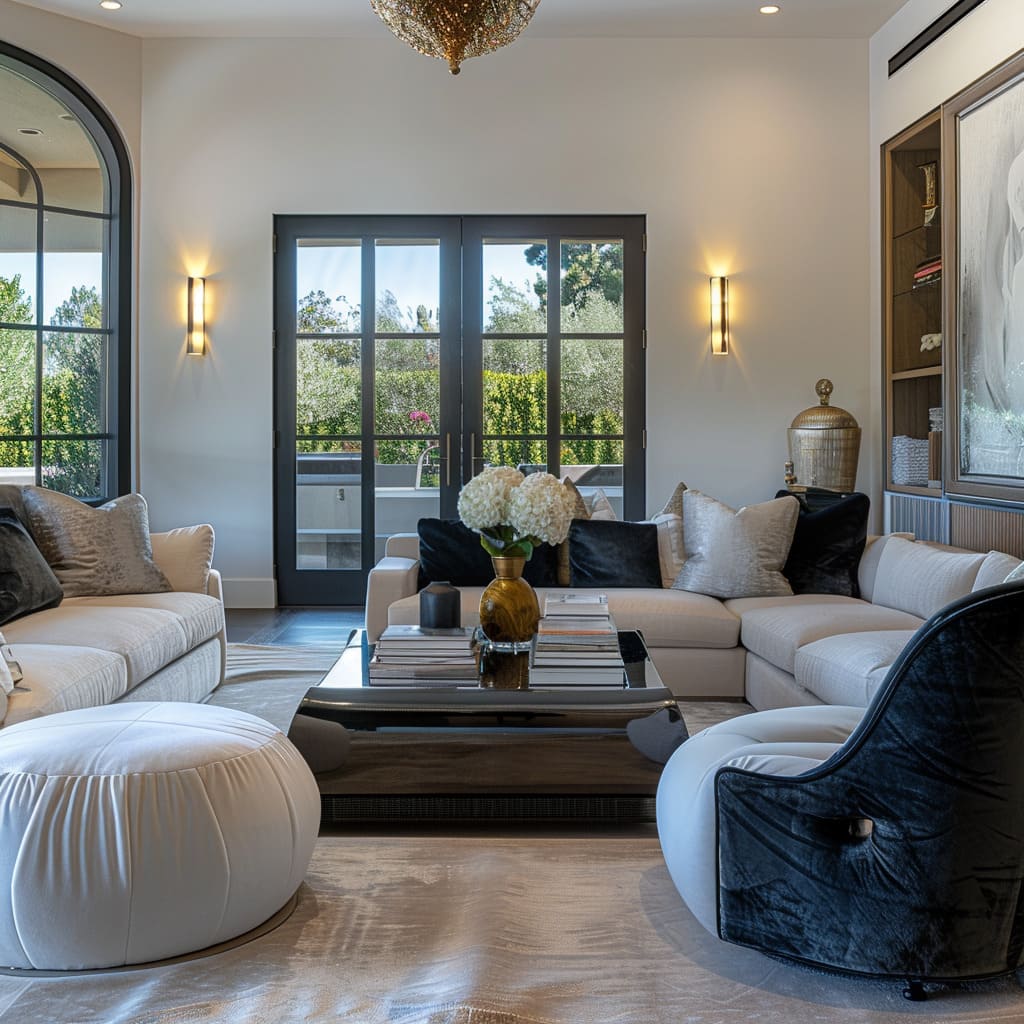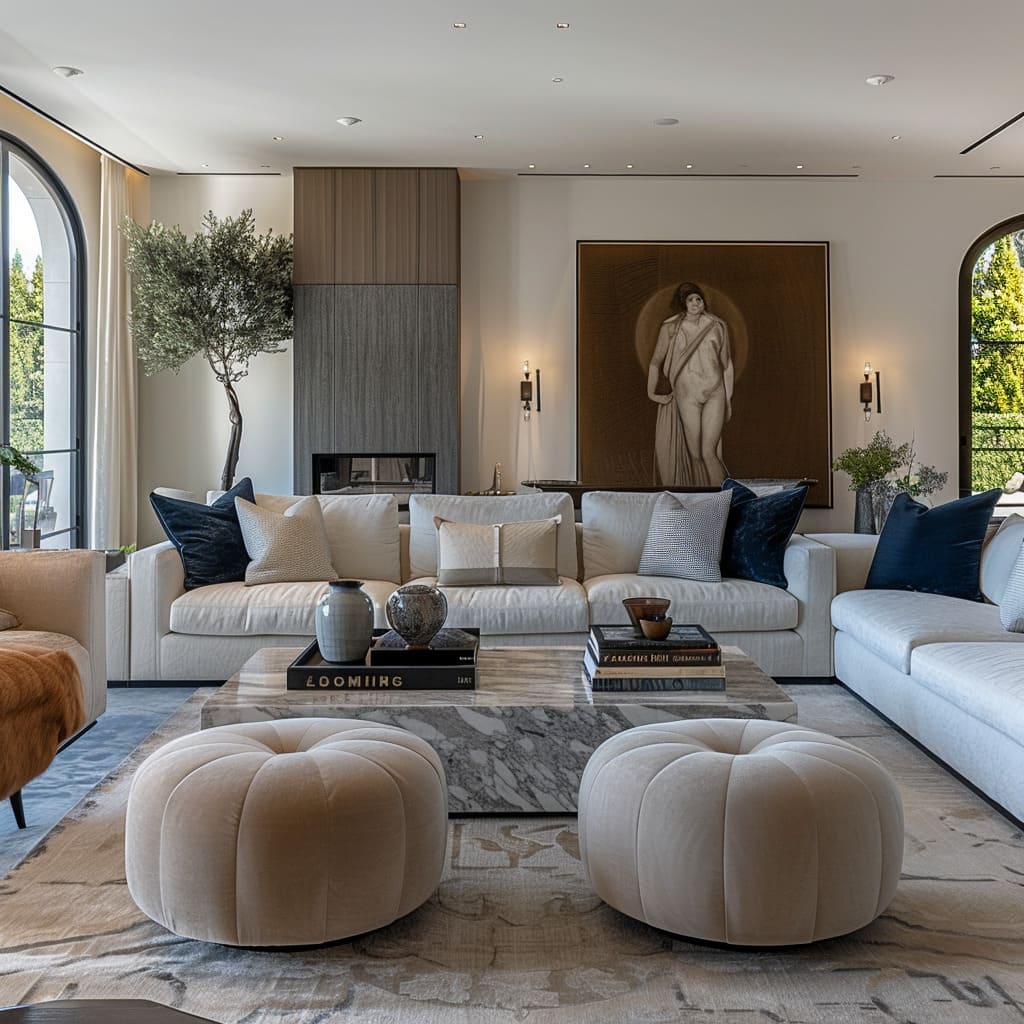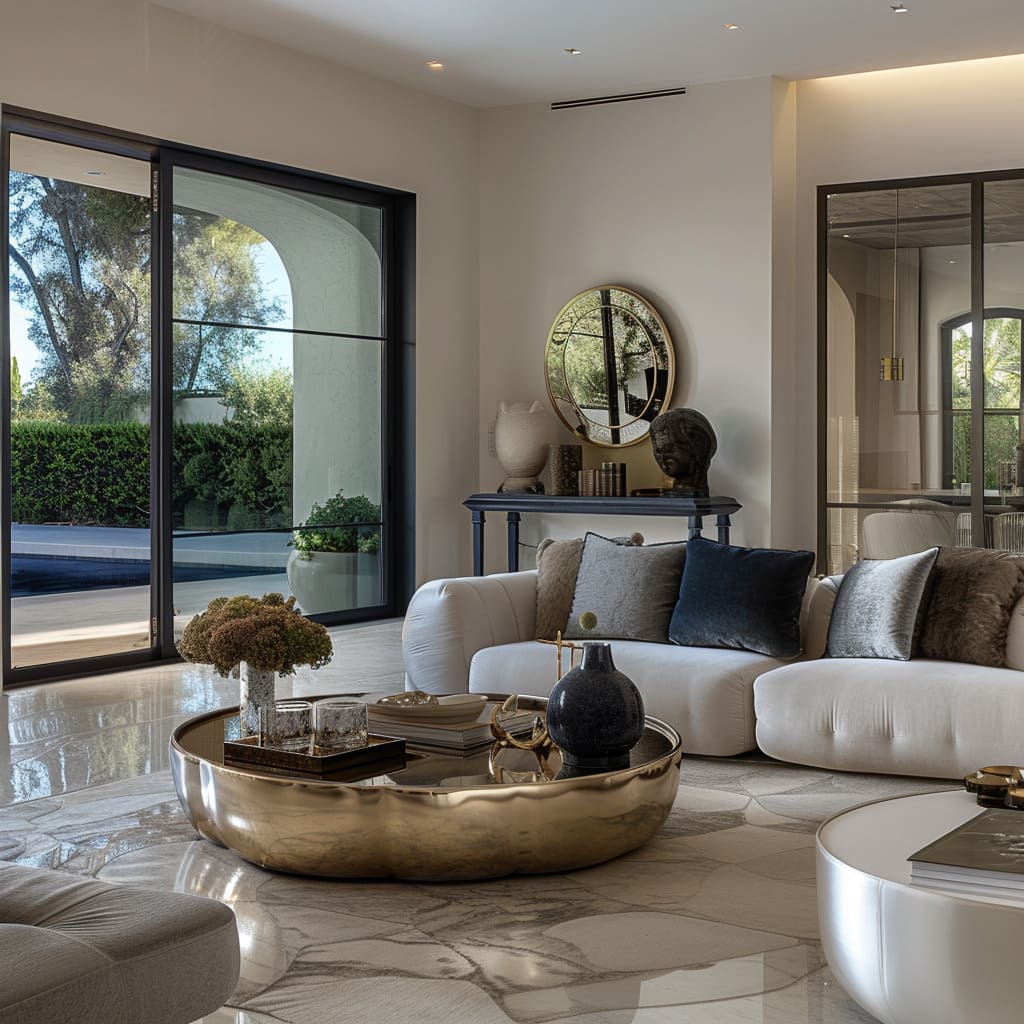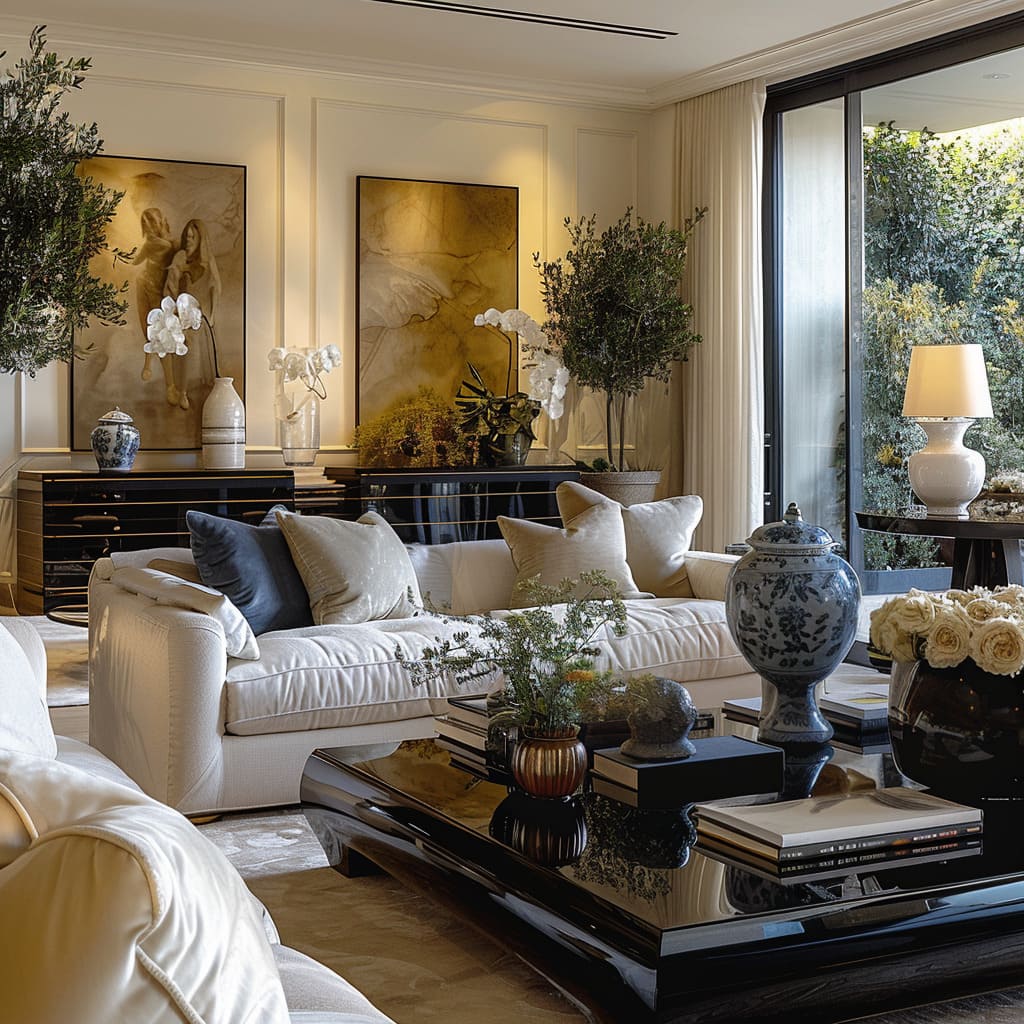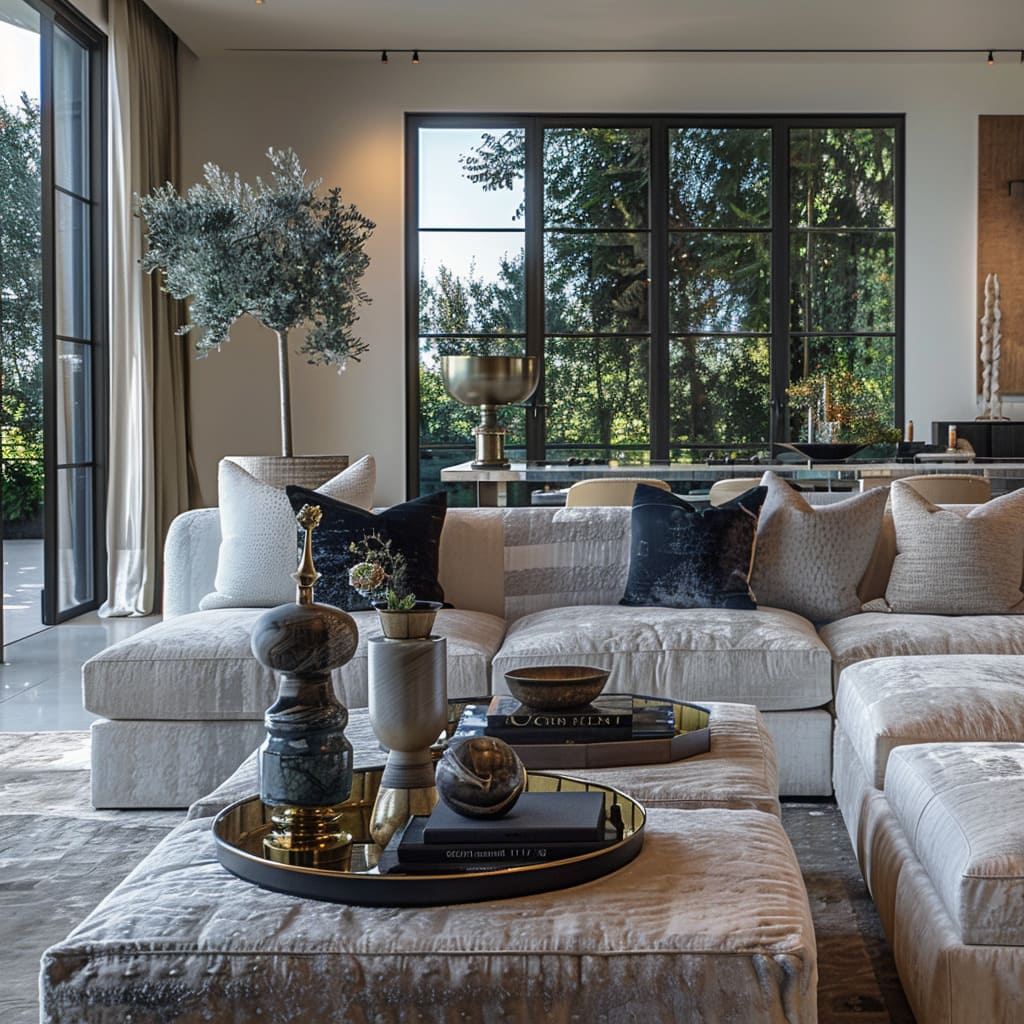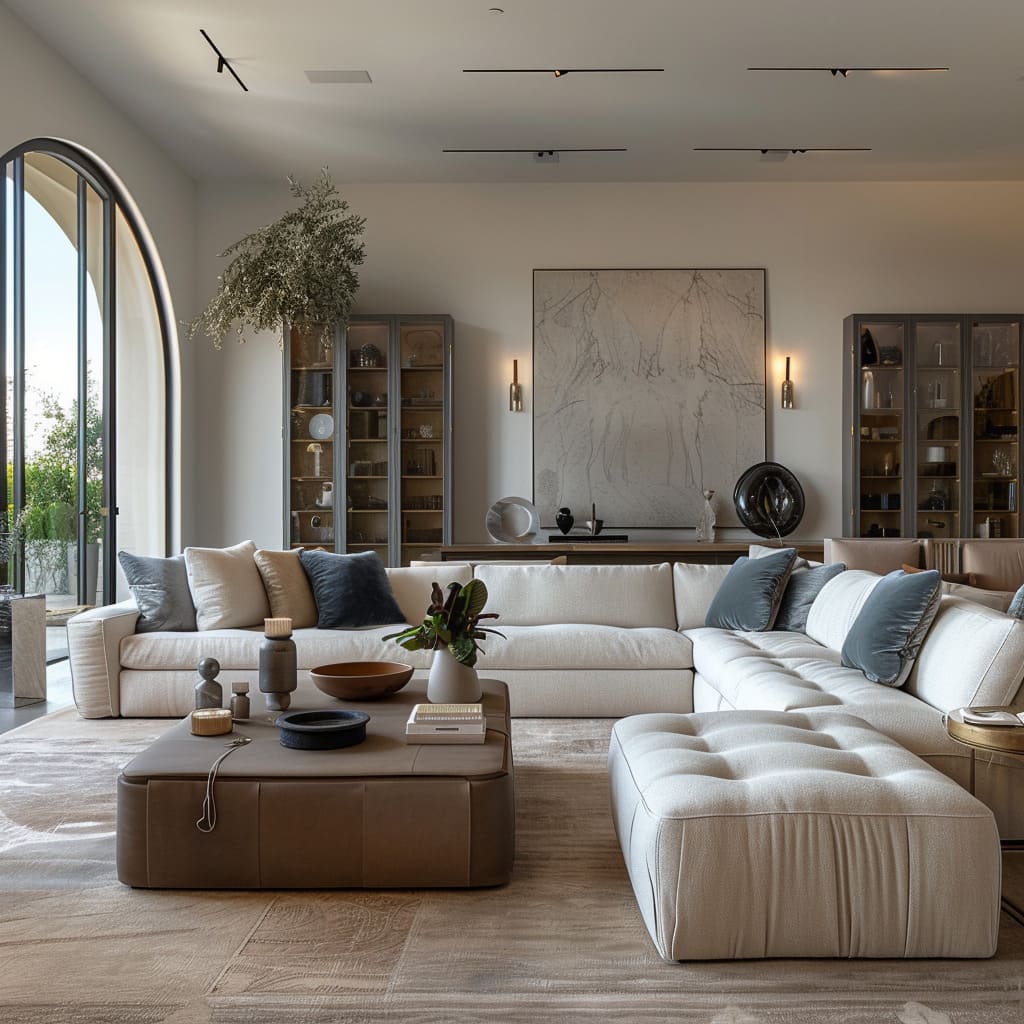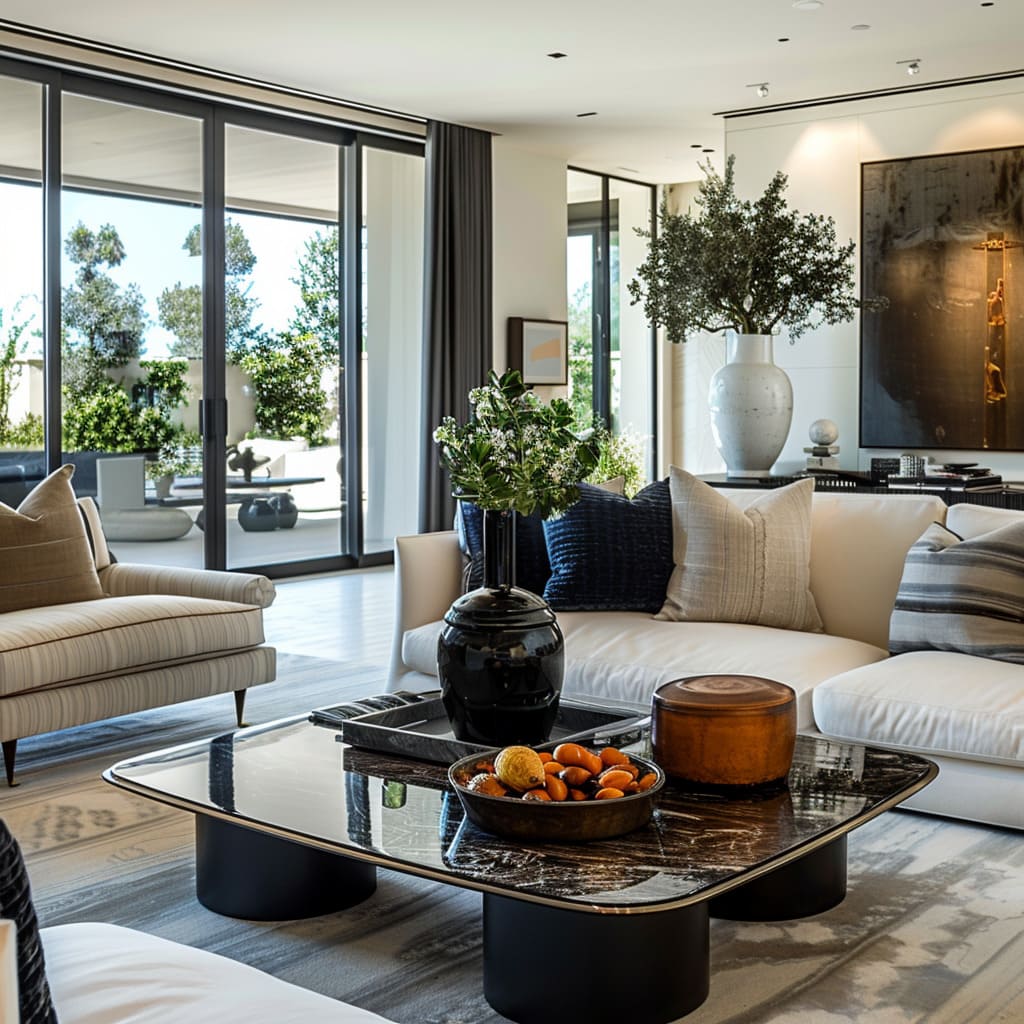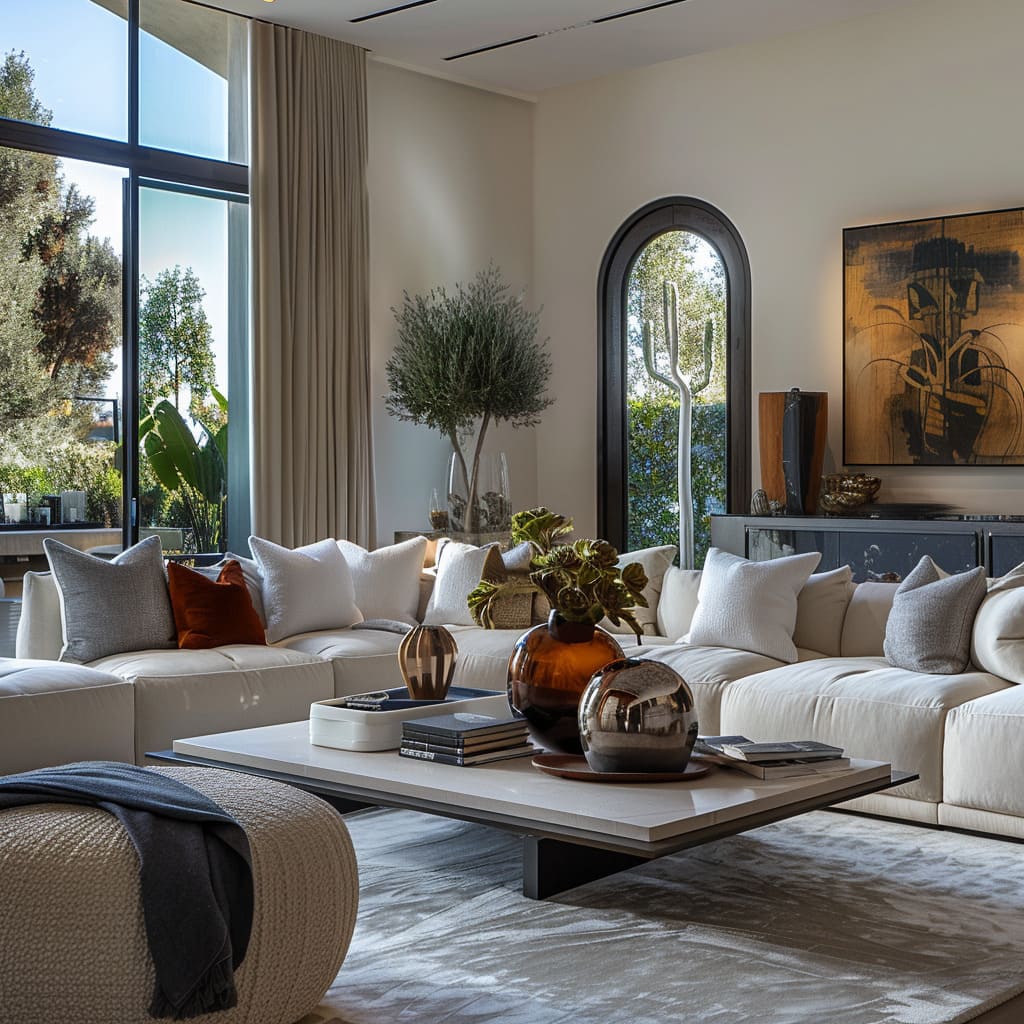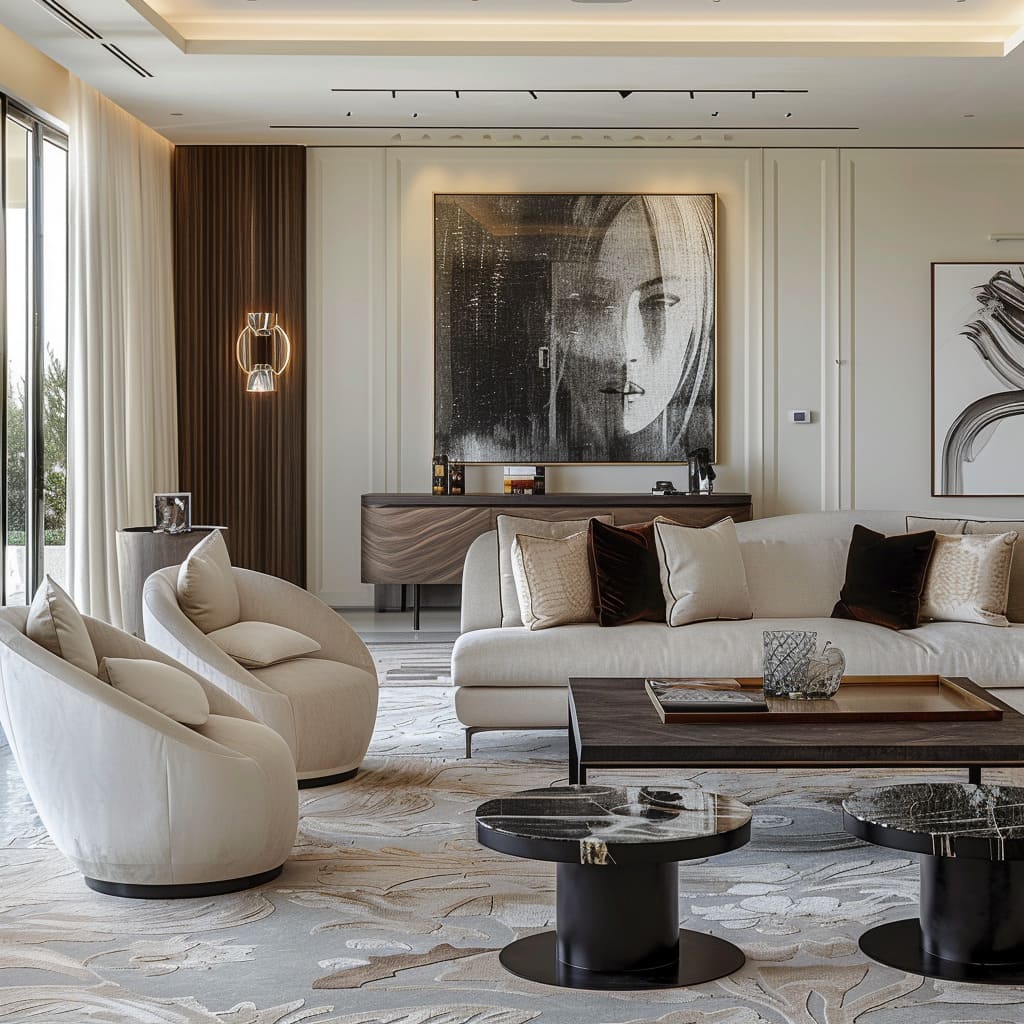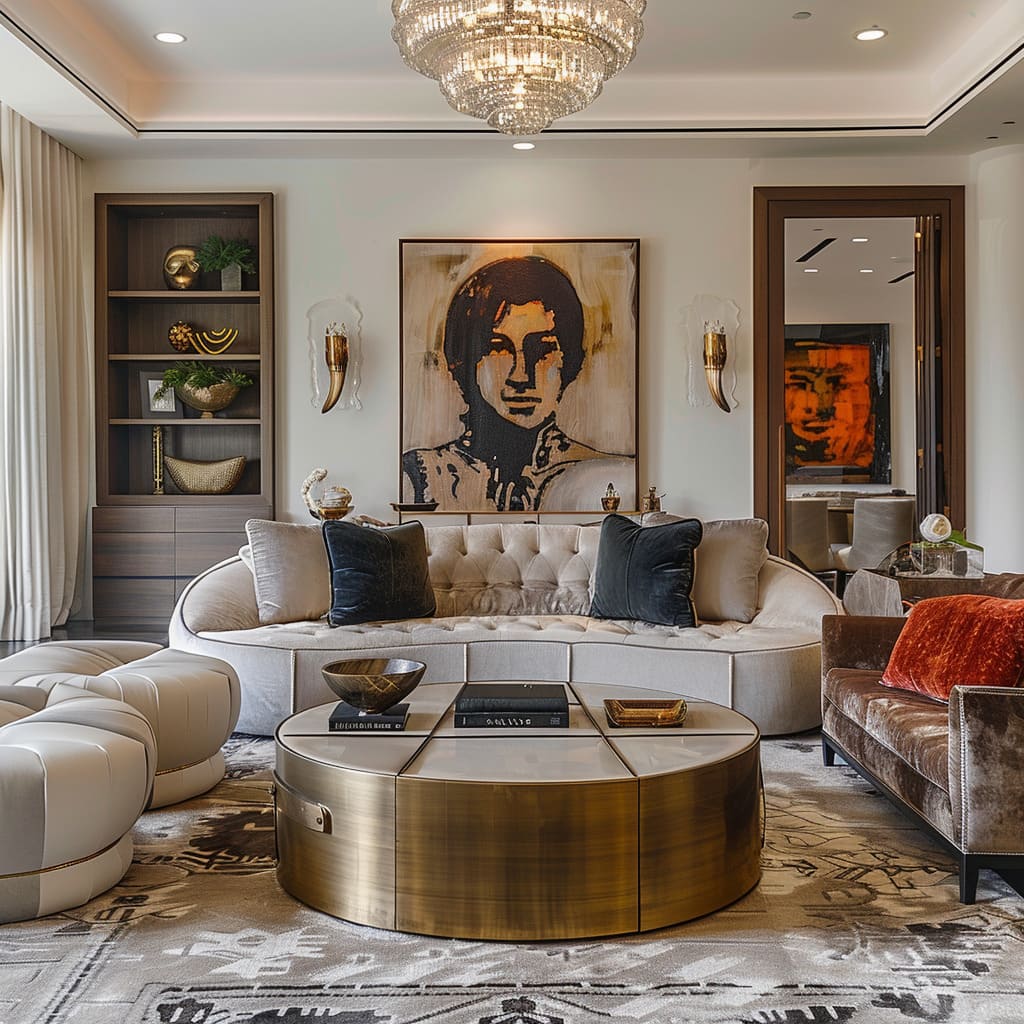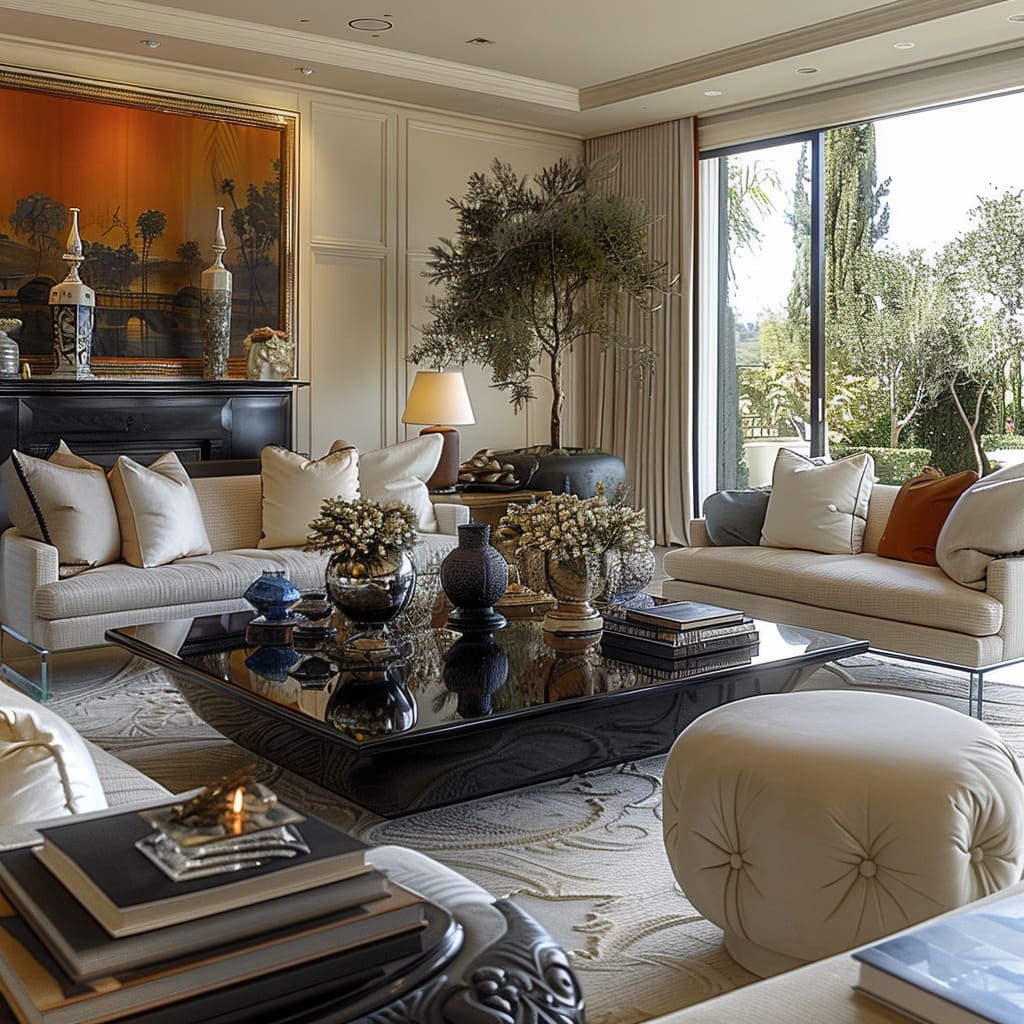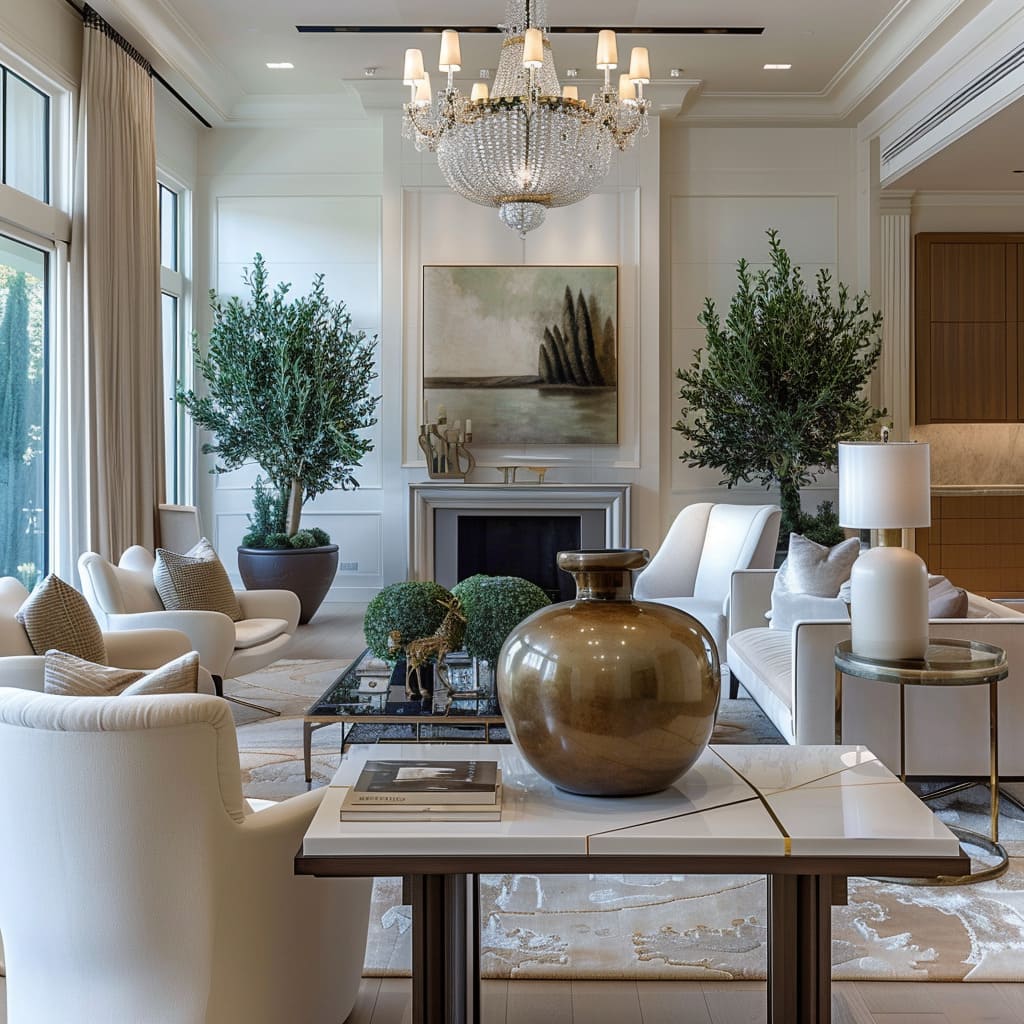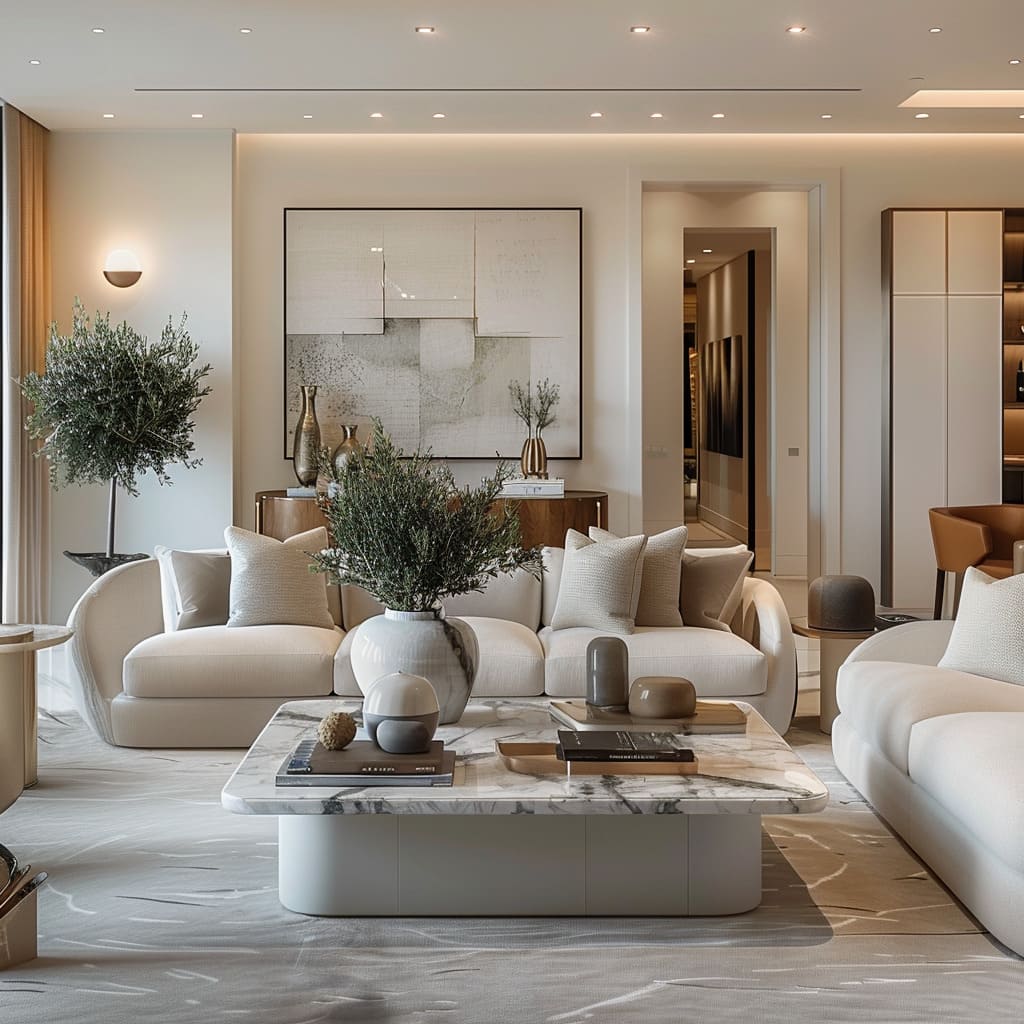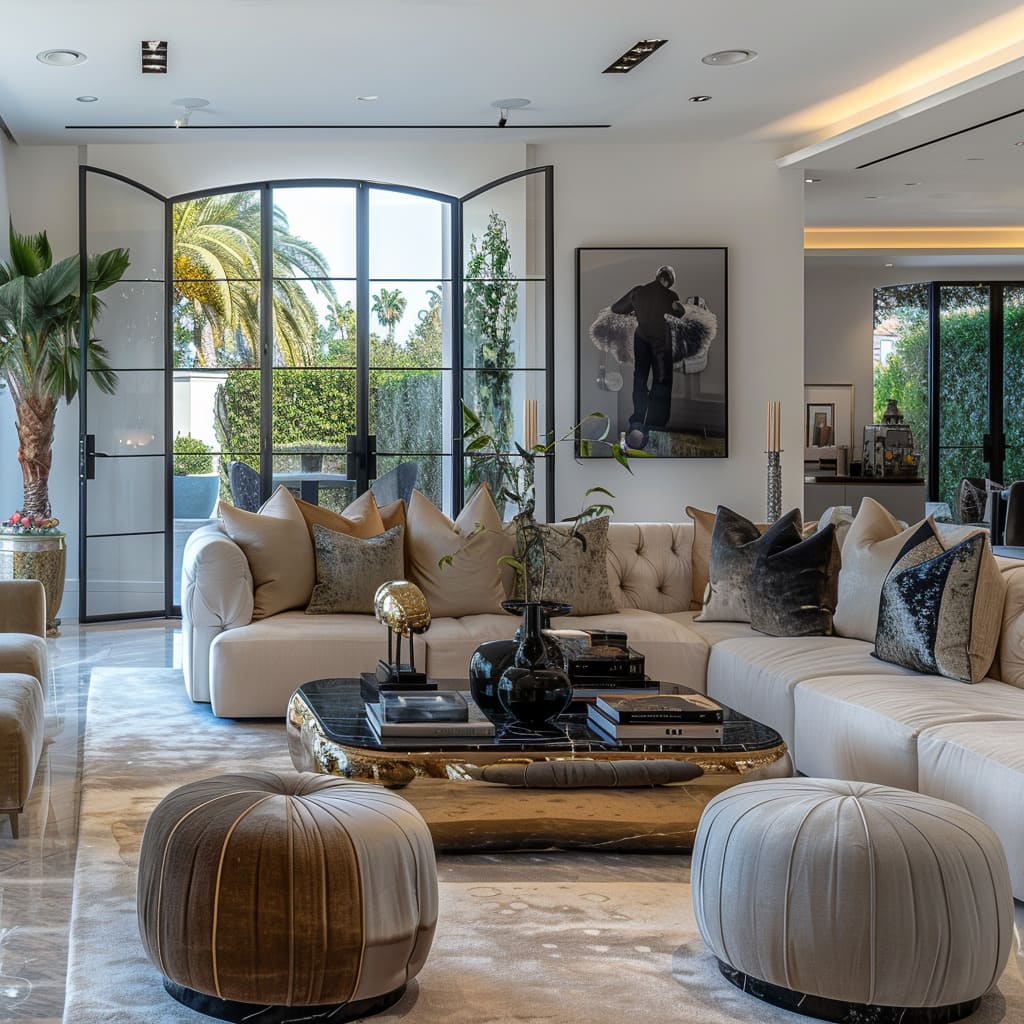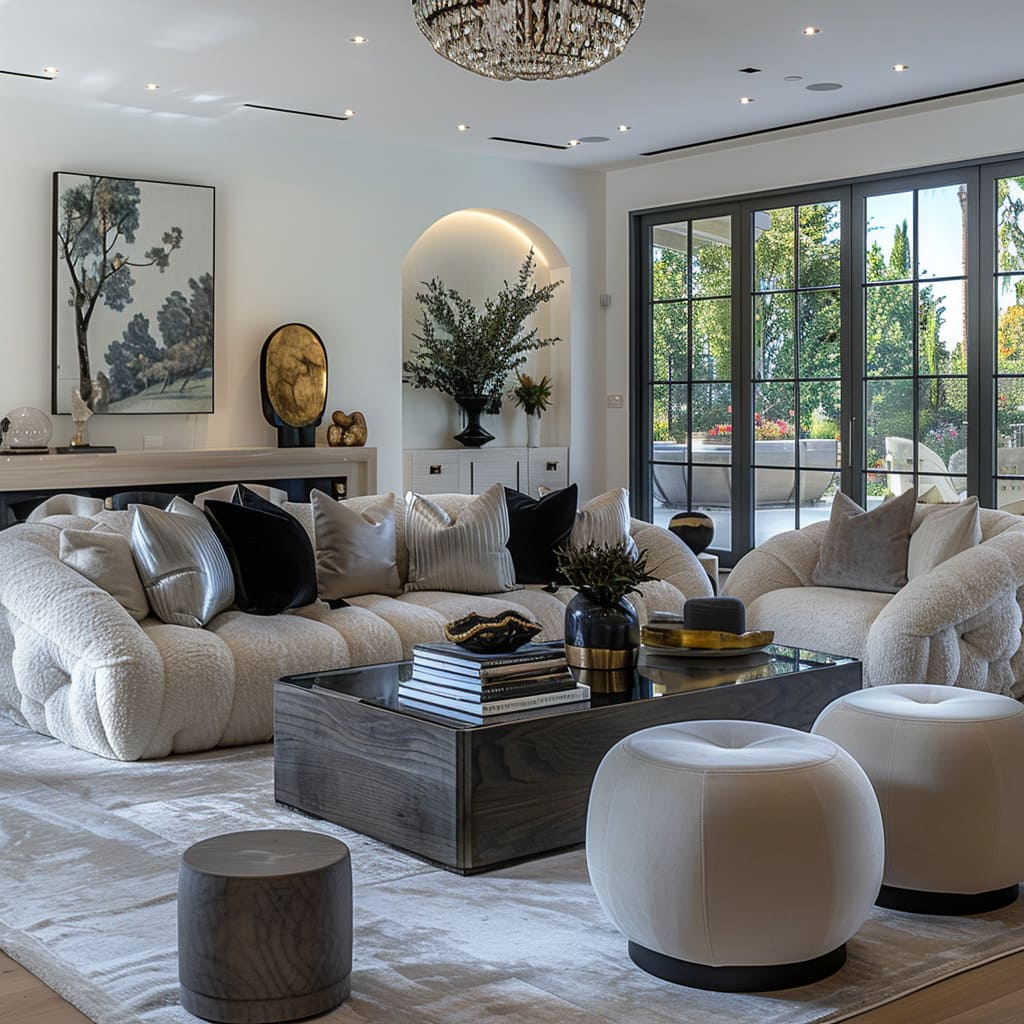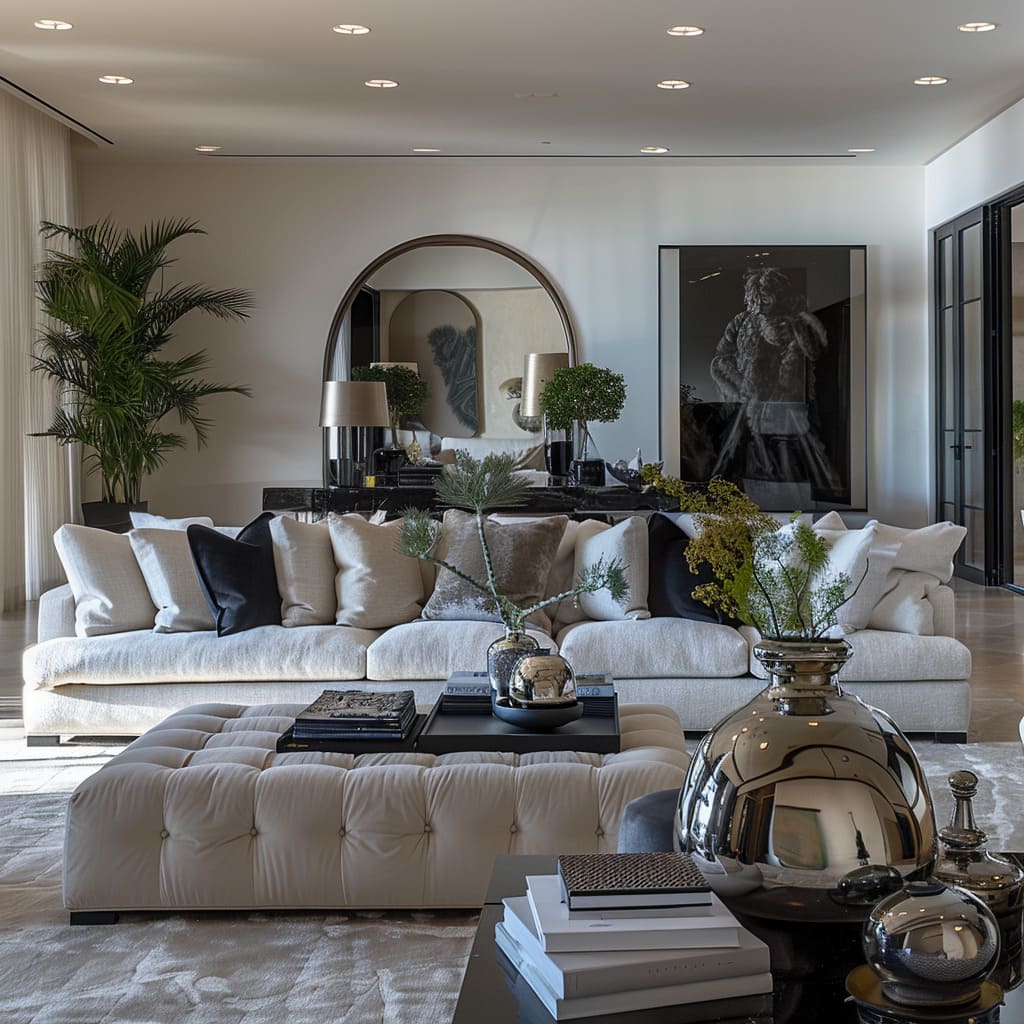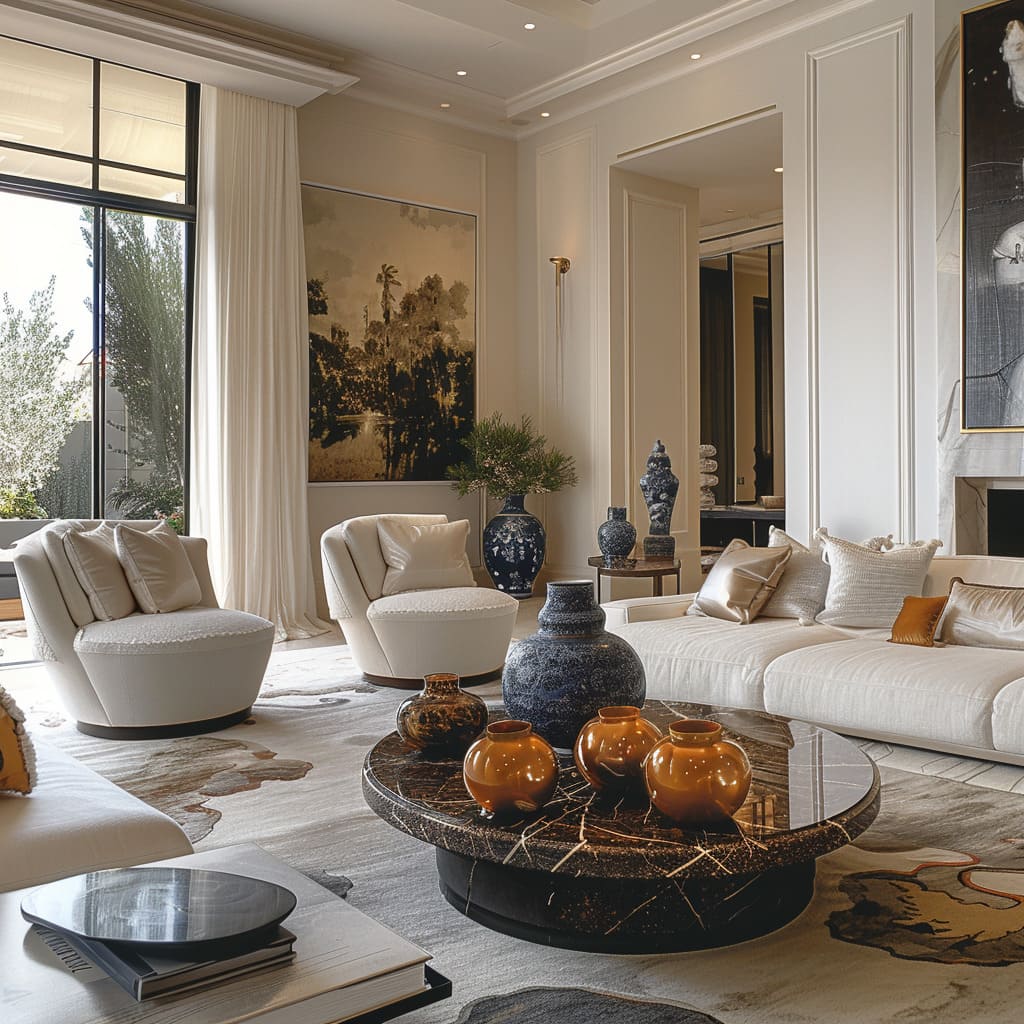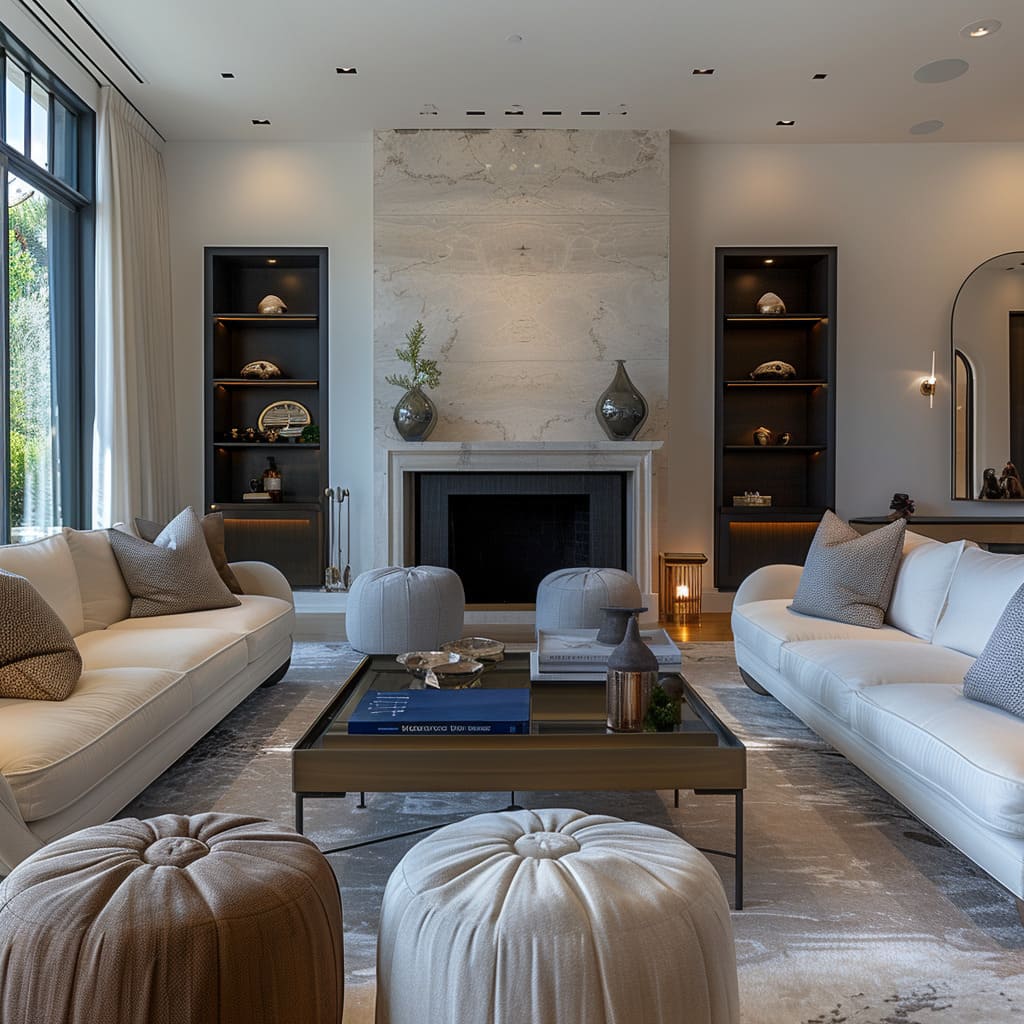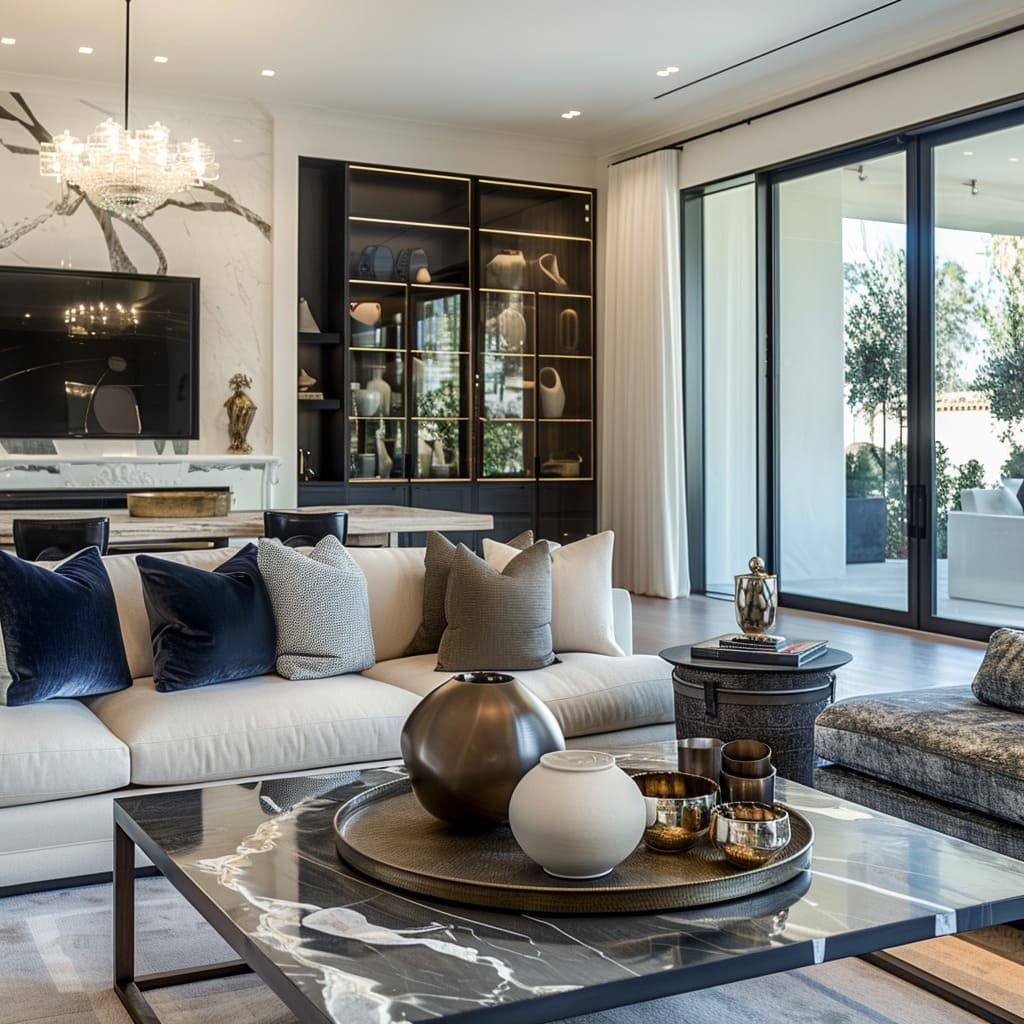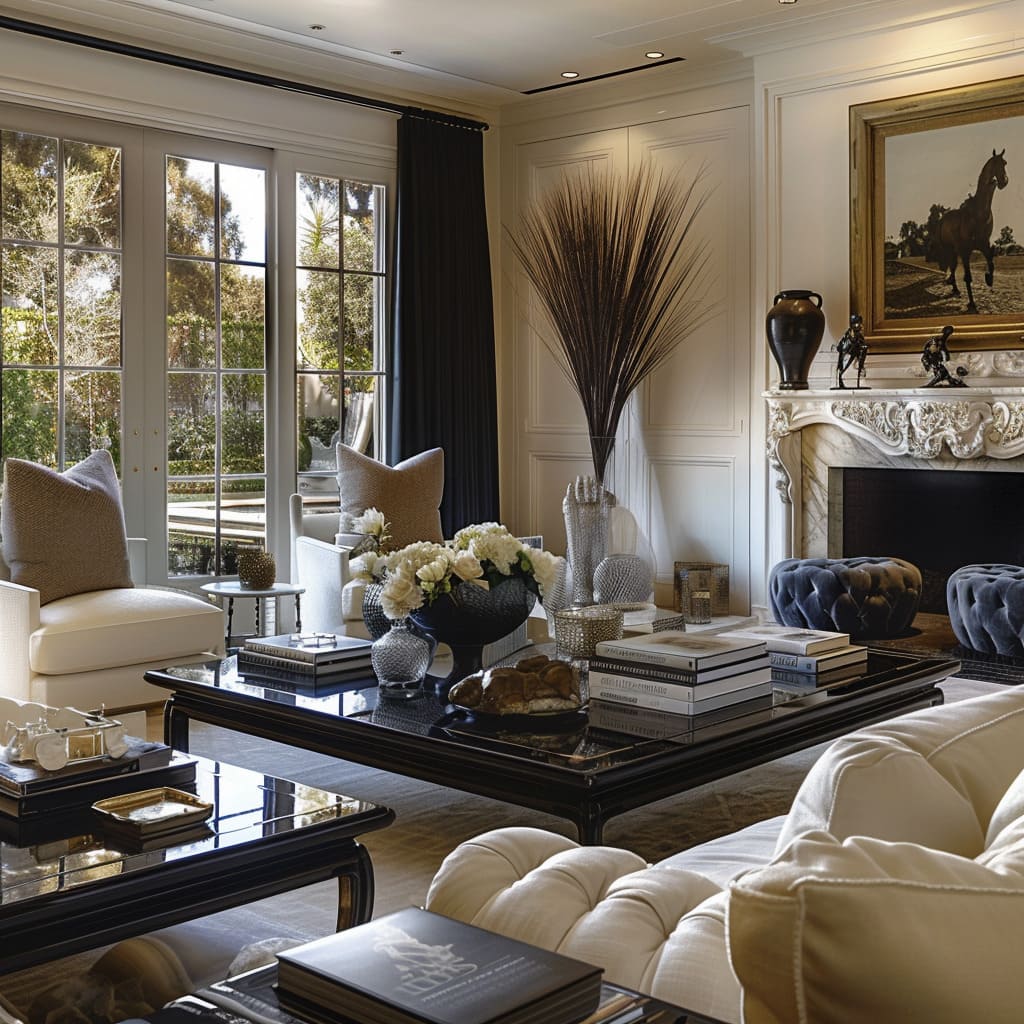The living room functions as more than just a part of the home—it’s a reflection of personal style and functional needs, where aesthetics meet comfort. Today’s living room is a testament to thoughtful arrangement and design harmony, where every piece of furniture and decor plays a crucial role in crafting an inviting and cohesive space.
As we explore the nuances of furniture selection and spatial arrangement, we’ll see how these elements come together to create environments that are not only pleasing to the eye but also enrich the day-to-day experiences of those who dwell within them.
Artistic Focus and Decorative Accents
Art and decorative pieces are vital in adding personality and vibrancy to a living room. This section focuses on how oversized art and carefully selected decor items serve as standout features, enhancing the aesthetic and emotional appeal of the space.
Oversized Art Pieces as Focal Points
Oversized art pieces serve more than a decorative purpose; they command attention and set the tone of the room. Such artwork is strategically placed to draw the eye and act as the centerpiece, often influencing the choice and arrangement of other elements within the room.
Whether abstract paintings or dramatic photographs, these pieces contribute to a vibrant atmosphere that reflects the inhabitants’ tastes and personalities.
Decorating Expansive Wall Spaces Expansive wall spaces provide the perfect canvas for displaying singular, large-scale artworks. These artworks are chosen not only for their size but for their ability to complement the architectural features of the room.
Large pieces can transform the perception of space by visually breaking up expansive blank walls and adding depth and intrigue to the area.
Oversized Vases and Bowls as Design Elements In addition to art, oversized vases and bowls are utilized as significant design elements. These items, often in striking designs and textures, add a sculptural quality to the living room.
Positioned on floor spaces or tabletops, they contribute to the room’s layered look, balancing the scale of furniture and the height of ceilings.
Display of Sculptures and Artistic Bowls Decorative objects such as sculptures and artistic bowls are carefully displayed to enhance the room’s aesthetic. These objects often carry their artistic merit, crafted from materials that add a contrasting texture or a splash of color to the room.
Positioned in key visual points around the living space, they create points of interest and conversation, harmonizing with the larger artworks and contributing to the overall theme of the space. For those who appreciate the rich versatility of this palette, explore further into the upscale design with these featuring chic gray living room ideas that exemplify contemporary finesse.
Spatial Dynamics and Furniture Selection
The layout and furniture in a living room significantly influence its functionality and visual appeal. Focusing on the spatial dynamics and choice of furniture, these interiors illustrate how the right selections can transform the atmosphere of a room.
Contemporary living spaces are becoming a canvas for self-expression and functional design, focusing on creating an atmosphere that is both inviting and aesthetically coherent. In these spaces, the selection and arrangement of furniture play a crucial role in forming a harmonious environment.
By opting for spacious layouts, the design ensures that each piece can command its presence, avoiding a congested appearance and promoting a sense of openness. Curvaceous seating arrangements contribute to a gentle, inviting ambiance, their rounded contours bringing a softness to the spatial composition.
Low-profile furnishings are a conscious choice, facilitating unobstructed sightlines which enable an uninterrupted visual flow throughout the area. These pieces merge subtlety with the surrounding decor, emphasizing a broader visual connectivity.
Central coffee tables, often substantial in size, serve as focal points around which seating is organized, providing both a practical and a visual foundation to the social zones of the room. Their robust presence is balanced by the strategic placement of occasional chairs, which offer supplementary seating without contributing to a cluttered feel.
To enhance versatility, ottomans and poufs are interspersed within these settings, offering additional seating options that can be easily moved and adapted to the needs of the moment.
Their presence adds a layer of functional comfort and informality, inviting guests to relax. Similarly, side tables are not merely practical surfaces but are selected for their ability to complement the aesthetic narrative of the room, often echoing materials, shapes, or colors found elsewhere in the decor.
These elements collectively contribute to a living space that is not just a physical location but an amalgamation of comfort, style, and thoughtful design.
Textural and Material Harmony
The tactile experience of a room significantly influences its ambiance and comfort. This section emphasizes the interplay of different textures and materials and their collective impact on the atmosphere of the living room.
Use of Marble and Glass for Opulence Marble and glass are frequently utilized to convey a luxurious feel within living rooms. Marble, with its cool, smooth surface and distinctive veining, brings a natural element that is both visually appealing and opulent.
Glass elements, whether in the form of tabletops or decorative accents, enhance this sense of luxury by adding a clean, modern touch that complements the stately elegance of marble.
Combining Opaque and Translucent Materials The strategic use of both opaque and translucent materials adds depth and variety to the living space. Translucent materials such as frosted glass or lightweight fabrics allow light to diffuse softly through the room, creating a bright and airy feel.
From plush velvets to intricate weaves, every luxurious upholstered sofa tells a story of opulence and comfort. In contrast, opaque materials like wood and metal provide grounding elements that offer visual weight and texture diversity.
Rugs with Abstract Designs or Neutral Tones Rugs are an essential element in tying together the room’s decor. Those featuring abstract designs add a modern artistic touch, while rugs in neutral tones enhance the room’s color scheme without overpowering it.
The choice of rug can define seating areas and contribute to the overall flow and division of the space, making it feel more cohesive and intentionally designed.
Preference for Matte Finishes A prevailing trend in contemporary living room design is the use of matte finishes on walls and furniture. These finishes help absorb light rather than reflect it, reducing glare and giving the space a softer appearance.
Matte surfaces also play a practical role in hiding fingerprints and smudges, maintaining a clean and polished look throughout the area. This choice enhances the visual comfort of the room, allowing other design elements like lighting and art to stand out more prominently.
For enthusiasts of interior design who find allure in the contrast of deep hues against neutral backgrounds, the interplay of shadow and light in these living spaces might be particularly captivating. Delve into a curated selection of living rooms where deep colors assert their dominance, elegantly framed by subtle tones, right here in our featured collection.
Discover more through this seamless link: explore the depth of luxury.
Lighting and Atmospheric Ambience
Lighting plays a pivotal role in defining the atmosphere of a living room, going beyond mere functionality to establish mood and character. This section explores how the combination of light fixtures and natural light work together to create the desired ambiance in these spaces.
Statement-Making Light Fixtures Large, impactful light fixtures are often used as central decorative elements in living rooms. These fixtures are not just sources of light but serve as artistic statements, drawing the eye and anchoring the room’s decor.
Whether a dramatic chandelier, a series of pendant lights, or a sculptural floor lamp, these lighting elements add a layer of sophistication and can be the defining feature of the room, setting the tone from the moment one enters.
Draperies and Curtains for Softness and Warmth The use of draperies and curtains plays a critical role in modifying the lighting and enhancing the warmth of the room. These elements not only control the amount of natural light entering the space but also add texture and color to the interior design.
Soft, flowing fabrics help to diffuse light gently, casting a soft glow that enhances the cozy and welcoming feel of the room. Moreover, curtains can be coordinated with the room’s color scheme to reinforce the style and thematic elements.
Adjustable Lighting for Flexibility Adjustable lighting systems, such as dimmer switches and automated solutions, allow for flexibility in controlling the room’s illumination, making it easy to alter the atmosphere according to the time of day or the desired mood. This adaptability is crucial in a living space, as it supports various activities from reading and relaxing to entertaining guests.
Integration of Natural Light The integration of natural light is carefully considered in living room designs. Architects design window placements to maximize the capture of daylight, which can be adjusted with the use of smartly designed curtains and blinds.
This blend of natural and artificial light ensures that the living room remains a vibrant and inviting space throughout the day, with lighting that naturally transitions from the bright and energizing light of day to the soft and serene glow of evening.
Comfort and Homeliness
Beyond mere appearance, the true heart of a living room resides in the comfort it offers and the welcoming feeling it projects. This section explores how certain living rooms achieve a warm and inviting atmosphere, focusing on the elements that enhance coziness and a sense of home.
The selection of accent pillows is a crucial aspect of crafting a cozy ambiance. These pillows not only introduce pops of color to enliven the decor but are also essential in providing soft support.
Carefully chosen for their textures and hues, they complement the overall design while inviting you to relax and settle in comfortably. The varied shapes and sizes ensure that there’s a perfect spot for everyone to feel supported, whether sitting up or lounging back.
Additionally, the strategic placement of throw blankets plays a significant role in amplifying the room’s homeliness. These blankets, often found draped over couch arms or neatly folded at the foot of a chair, are readily available to wrap around oneself for an added layer of warmth.
Their materials range from plush fleece to luxurious wool, catering to different preferences and seasonal needs.
The choice of colors and patterns in these blankets not only serves a functional purpose but also ties into the room’s color scheme, enhancing the visual appeal and the feeling of a lived-in space.
Furthermore, the furniture arrangement in these living rooms encourages a welcoming and intimate setting. Sofas and armchairs are positioned to face each other, promoting conversation and interaction among family and guests.
This setup ensures that each seat is accessible and offers a clear view of the focal points of the room, be it a fireplace, television, or stunning outdoor scenery through large windows.
Lastly, the lighting choices in these living rooms also contribute significantly to the atmosphere of comfort. Soft, layered lighting from a combination of sources—overhead fixtures, floor lamps, and table lamps—creates a gentle glow that avoids harsh shadows and bright spots.
This thoughtful illumination not only enhances the room’s aesthetics but also creates a soothing environment conducive to relaxation at any time of the day.
Together, these elements combine to create living spaces that are not just beautiful but are truly spaces where comfort and welcoming warmth are a priority.
The living room stands out as a central space in any home, serving as a backdrop for family gatherings, a quiet place for relaxation, and a canvas for personal expression. Through the strategic use of furniture, art, and light, these rooms gain a dynamic that is both functional and visually appealing.
As we have explored different aspects of living room design, from the placement of art to the selection of materials, it becomes clear that each choice is integral to forging an atmosphere that is uniquely welcoming. In crafting spaces that resonate with warmth and style, we not only enhance the beauty of our homes but also improve the quality of our living.

